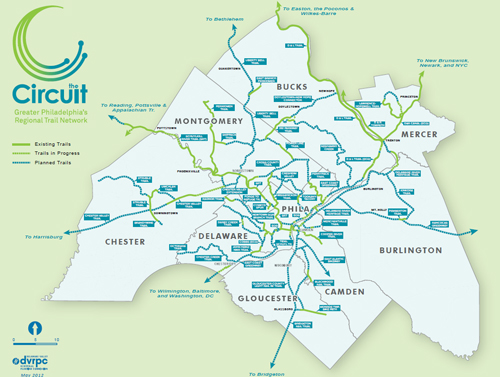
In a bit of good news for cycling and pedestrian safety advocates, 48 states have chosen to keep their recreational trails funding whole—including all three states in our region. News arose of a potential New York State opt-out in late August, but a successful advocacy push helped avert that outcome. Under the terms of MAP-21, America’s new national transportation bill, states have the option of leaving dedicated recreational trails funding intact or shuffling it into the general cyclist/pedestrian project pot called “Transportation Alternatives,” where 50 cents of every dollar could be transferred to non-cyclist/pedestrian projects (like road expansion).
Those states that have opted in will receive trails funding at 2009 levels—New York is set to receive over $2 million, New Jersey over $1 million, and Connecticut just under $1 million. In New York, this means that the state can pursue more projects like Highbridge Park, in New Jersey, The Circuit’s trails could continue to get a boost from these federal funds, and in Connecticut, good, well-maintained bicycle and pedestrian infrastructure in places like Hartford’s Keney Park could become more common.
With overall cyclist and pedestrian funding down by about 1/3 in the new federal transportation bill, New York, New Jersey, and Connecticut did well to seize these funds. Now, they must also commit to investing the full total of allocated Transportation Alternatives funding on cyclist and pedestrian projects.

[…] Tri-State DOTs (and 45 others) Opt to Keep “Recreational Trails” Funding (MTR) […]
This is great, although the term “recreational trail” is a bit of a misnomer. Every day, trails are becoming more and more about transportation. The trails can provide safe, protected routes for people on foot and bike traveling to transit hubs and their jobs. And for kids, they can be a particularly convenient “safe route to school.”
Many trails need to operate 365/24/7 as an integral part of the transportation system. That means lighting, plowing, and wayfinding signage. Secure bike parking and public faciliities (like bathrooms). And integration with government mapping systems to ensure effective policing (Call to 911: “I don’t know where I am!”) and route guidance from online direction services (Google Maps).
[…] has chosen to put its federal “recreational trails” funding to use. Sam Handler at Mobilizing the Region explains how the political decision-making has been playing out: In a bit of good news for cycling […]
[…] month, New York State (along with New Jersey and Connecticut) agreed to keep recreational trails funding whole, instead of moving it into a pot of money that is vulnerable to raids for automobile-focused […]